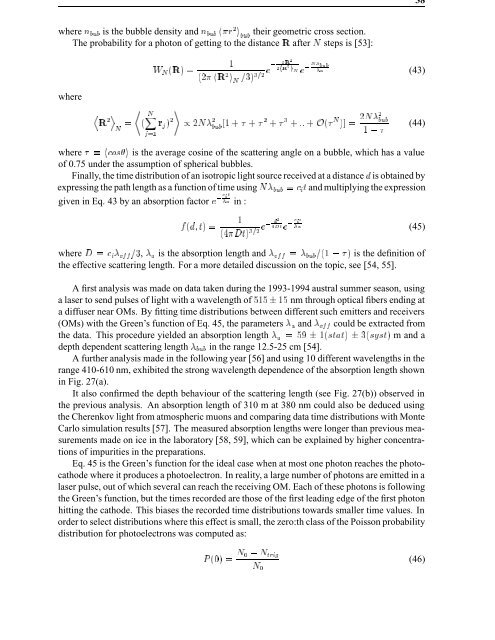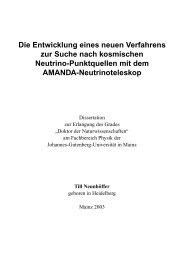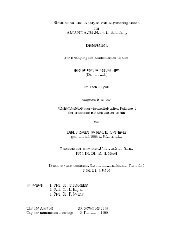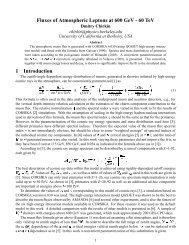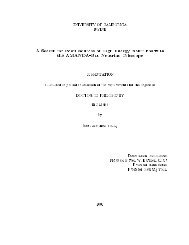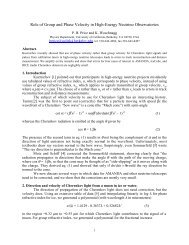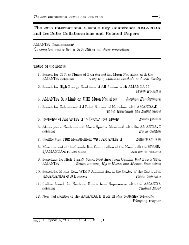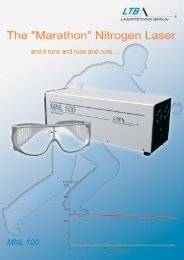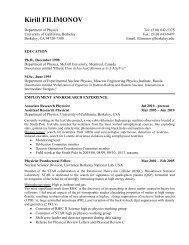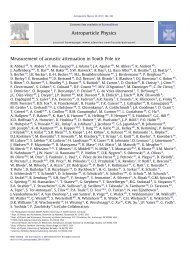Link to Fulltext
Link to Fulltext
Link to Fulltext
Create successful ePaper yourself
Turn your PDF publications into a flip-book with our unique Google optimized e-Paper software.
£<br />
¤ ¤ ¢ ¤ ¤<br />
§<br />
¢ ¤<br />
¤ ¤ where is the bubble density and their geometric cross section.<br />
The probability for a pho<strong>to</strong>n of getting <strong>to</strong> the distance after steps is [53]:<br />
where<br />
£<br />
¦<br />
<br />
<br />
<br />
<br />
<br />
¤<br />
<br />
¤ <br />
<br />
<br />
¦<br />
§<br />
<br />
¤ ¤<br />
£<br />
¤ <br />
¦ ¡<br />
<br />
<br />
<br />
¡<br />
<br />
<br />
©¢¡¤£ <br />
¦¥ £ ¨§© © <br />
¡<br />
<br />
¡<br />
©<br />
<br />
¡ <br />
¦ <br />
<br />
¤ ¤<br />
£<br />
¤<br />
¦ is the average cosine of the scattering angle on a bubble, which has a value<br />
where<br />
of 0.75 under the assumption of spherical bubbles.<br />
Finally, the time distribution of an isotropic light source received at a distance £<br />
is obtained by<br />
expressing the path length as a function of time using <br />
¤<br />
<br />
§<br />
¦<br />
¤<br />
©<br />
and multiplying the expression<br />
given in Eq. 43 by an absorption fac<strong>to</strong>r in :<br />
<br />
£ <br />
<br />
<br />
¦<br />
£§<br />
<br />
where © <br />
<br />
, is the absorption ¤ ¤<br />
<br />
<br />
length and is the definition of<br />
the effective scattering length. For a more detailed discussion on the <strong>to</strong>pic, see [54, 55].<br />
¦<br />
<br />
© <br />
¦ © <br />
A first analysis was made on data taken during the 1993-1994 austral summer season, using<br />
a laser <strong>to</strong> send pulses of light with a wavelength of nm through optical fibers ending at<br />
a diffuser near OMs. By fitting time distributions between different such emitters and receivers<br />
(OMs) with the Green’s function of Eq. 45, the parameters © and could be extracted from<br />
the data. This procedure yielded an absorption length © <br />
m and a<br />
¦ <br />
depth dependent scattering length <br />
in the range 12.5-25 ¤ ¤ cm [54].<br />
A further analysis made in the following year [56] and using 10 different wavelengths in the<br />
range 410-610 nm, exhibited the strong wavelength dependence of the absorption length shown<br />
in Fig. 27(a).<br />
It also confirmed the depth behaviour of the scattering length (see Fig. 27(b)) observed in<br />
the previous analysis. An absorption length of 310 m at 380 nm could also be deduced using<br />
the Cherenkov light from atmospheric muons and comparing data time distributions with Monte<br />
Carlo simulation results [57]. The measured absorption lengths were longer than previous measurements<br />
made on ice in the labora<strong>to</strong>ry [58, 59], which can be explained by higher concentrations<br />
of impurities in the preparations.<br />
Eq. 45 is the Green’s function for the ideal case when at most one pho<strong>to</strong>n reaches the pho<strong>to</strong>cathode<br />
where it produces a pho<strong>to</strong>electron. In reality, a large number of pho<strong>to</strong>ns are emitted in a<br />
laser pulse, out of which several can reach the receiving OM. Each of these pho<strong>to</strong>ns is following<br />
the Green’s function, but the times recorded are those of the first leading edge of the first pho<strong>to</strong>n<br />
hitting the cathode. This biases the recorded time distributions <strong>to</strong>wards smaller time values. In<br />
order <strong>to</strong> select distributions where this effect is small, the zero:th class of the Poisson probability<br />
distribution for pho<strong>to</strong>electrons was computed as:<br />
¥<br />
¡ <br />
¦<br />
<br />
<br />
<br />
<br />
¦<br />
§ <br />
<br />
<br />
38<br />
(43)<br />
(44)<br />
(45)<br />
(46)


